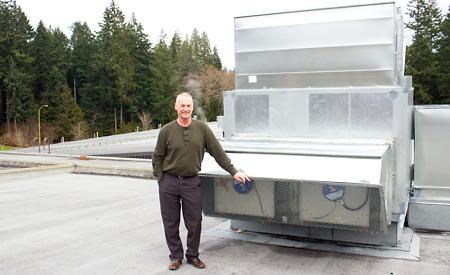An energy retrofit at Powell River Recreation Complex is expected to save the City of Powell River approximately $60,000 a year in energy costs. Installation of a UV (ultraviolet) filtration system will be the last in a series of upgrades that will also dramatically reduce the facility’s carbon footprint.
Recreation manager Ross deBoer explained that the city was asked for grant money under the Community Works Fund to finance the project.
“Indoor community swimming pools are notoriously some of the most energy-wasteful facilities in Canada,” deBoer said. “Most of the upgrades are now done, save for the UV installation.”
Phase one included a new exhaust air reclaim system, a dehumidification reclaim for domestic hot water (DHC) heating, a pump room air conditioner used to heat the swirl pool, and a solar ambient heating system for DHC, he said. The facility’s heating, ventilation and air conditioning (HVAC) direct digital controls were also replaced.
Further improvements include installation of a door from the pool area leading to the women’s change room that will make it possible for a new energy measurement information system (EMIS) to create a negative pressure and balance the pool environment. The intuitive system will receive readings from newly installed gas and electrical pulse meters. The pulse generated is translated into a verification system that measures the energy consumed by the building. These real-time measurements will be displayed on a flat screen in the lobby.
“The EMIS component demonstrates first-hand the efficiency and sophistication of the retrofit,” deBoers said. “The technology shows clearly how far the science and engineering behind pool management has come.”
The entire first phase of the upgrade came with a capital cost of $618,406. Phase two is estimated at around $173,805. “The budget for the entire refit will be close to $800,000,” deBoer said. “After everything is finished we are looking at a reduction in GHG [greenhouse gas] emissions by 224 tonnes of carbon dioxide, or 83 per cent. This represents an energy cost savings of around $60,000 annually, as well as a reduction in the energy footprint of the facility by 48.5 per cent.”
In little more than a decade the city could see a return on its initial investment. The final phase of the retrofit involves installation of a UV filtering system. The system improves air quality and reduces bacteria that chlorine doesn’t kill. However, this method of filtration only treats water at the source. As a result, the amount of chlorine used in the water can be reduced, but it would be a minimal decrease. Work for this final phase is planned during the upcoming summer closure of the pool this June for scheduled maintenance.



